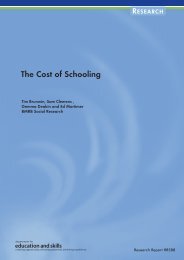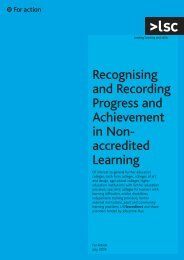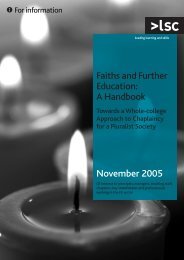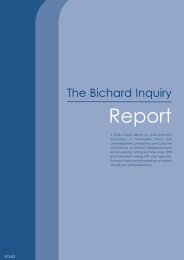The Learning and Skills Councils Annual Report and Accounts for ...
The Learning and Skills Councils Annual Report and Accounts for ...
The Learning and Skills Councils Annual Report and Accounts for ...
Create successful ePaper yourself
Turn your PDF publications into a flip-book with our unique Google optimized e-Paper software.
Provider Financial<br />
Assurance<br />
38. As Accounting Officer I was<br />
required to be satisfied that those<br />
organisations that the LSC funded<br />
also operated in an appropriately<br />
controlled environment. <strong>The</strong> LSC<br />
had a Provider Financial Assurance<br />
(PFA) function, with responsibility<br />
<strong>for</strong> co-ordinating <strong>and</strong> carrying out<br />
a programme of visits designed to<br />
gain assurances over the systems<br />
of control operated by providers<br />
<strong>and</strong> also providers’ use of LSC<br />
funds. <strong>The</strong> level of assurance work<br />
carried out by PFA teams, or by<br />
others on which PFA teams relied,<br />
was commensurate with the level<br />
of associated risks. I received from<br />
each of my regional directors their<br />
personal assurance that providers<br />
maintained <strong>and</strong> operated adequate<br />
controls. <strong>The</strong>y based this assurance<br />
on a number of things, <strong>for</strong>emost of<br />
which were:<br />
• PFA reports<br />
•<br />
receipt <strong>and</strong> examination of<br />
FE college accounts <strong>and</strong> audit<br />
reports<br />
• contract managers’ reports<br />
• per<strong>for</strong>mance reviews<br />
•<br />
•<br />
Audit Committee scrutiny, <strong>and</strong><br />
third-party assurance (from<br />
Ofsted <strong>and</strong> the Higher<br />
Education Funding Council<br />
<strong>for</strong> Engl<strong>and</strong>).<br />
Responsibility<br />
<strong>for</strong> the review of<br />
the effectiveness<br />
of the system of<br />
internal control<br />
39. As Accounting Officer I had<br />
responsibility <strong>for</strong> reviewing the<br />
effectiveness of the system of<br />
internal control. My review was<br />
in<strong>for</strong>med by the work of our<br />
internal auditors; the Management<br />
Group within the LSC, who had<br />
responsibility <strong>for</strong> the development<br />
<strong>and</strong> maintenance of the internal<br />
control framework; the LSC’s audit<br />
team, which reviews the records<br />
<strong>and</strong> claims of providers; the<br />
external auditors of our providers;<br />
<strong>and</strong> comments made by the<br />
National Audit Office as the LSC’s<br />
external auditor in its reports.<br />
I was advised on the implications<br />
of the result of my review of<br />
the effectiveness of the system<br />
of internal control by the Audit<br />
Committee, the Management<br />
Group <strong>and</strong> Internal Audit. I also<br />
evaluated the Statements on<br />
Internal control from regional <strong>and</strong><br />
national office directors in support<br />
of the review of effectiveness.<br />
Internal control<br />
issues<br />
40. As Accounting Officer I was<br />
satisfied, with the exception of<br />
risk management in the initial<br />
part of the year, that the LSC’s<br />
governance <strong>and</strong> internal control<br />
were consistent with the principles<br />
of Managing Public Money during<br />
2009–10.<br />
41. Where control weaknesses have<br />
been identified, action has been<br />
taken to manage risks <strong>and</strong> improve<br />
internal control. <strong>The</strong> following<br />
sections describe some of the<br />
key issues.<br />
Risk management<br />
42. <strong>The</strong> Chief Internal Auditor’s<br />
report was qualified in recent<br />
years based on assessments that<br />
risk management was not fully<br />
embedded within the organisation.<br />
43. A new risk management process<br />
was developed to address these<br />
issues following the appointment<br />
of a new Chief Executive. In May<br />
2009, a new Per<strong>for</strong>mance <strong>and</strong><br />
Risk <strong>Report</strong> was introduced that<br />
<strong>for</strong>med a key part of the new<br />
process. Internal Audit was wholly<br />
supportive of its introduction.<br />
<strong>The</strong> report provided a means of<br />
monitoring key business activity,<br />
reporting progress <strong>and</strong> risk <strong>and</strong><br />
holding Senior Responsible Owners<br />
(SROs) to account.<br />
44. Other structural changes<br />
were made to provide better<br />
co-ordination of the receipt of risk<br />
templates <strong>and</strong> their subsequent<br />
analysis <strong>and</strong> inclusion in the<br />
Per<strong>for</strong>mance <strong>and</strong> Risk <strong>Report</strong>.<br />
45. Internal Audit had previously<br />
recommended that focus needed<br />
to be directed towards the early<br />
identification of emerging risks.<br />
A horizon-scanning process was<br />
introduced in mid-2009 to address<br />
this issue. All regional <strong>and</strong> national<br />
directors <strong>and</strong> other senior staff<br />
submitted a horizon scan covering<br />
their area of responsibility<br />
on a <strong>for</strong>tnightly basis. To aid<br />
consistency, responses were<br />
co-ordinated by the same team<br />
that produced the Per<strong>for</strong>mance<br />
<strong>and</strong> Risk <strong>Report</strong> <strong>and</strong> any relevant<br />
Leadership <strong>and</strong> Governance<br />
LSC <strong>Annual</strong> <strong>Report</strong> <strong>and</strong> <strong>Accounts</strong> 2009–10 37
















